Introduction
Demand and supply are the fundamentals of economic analysis as the interaction of the two forms a market. The law of demand and supply works in opposite ways in the sense that, when the prices of commodities change, demand and supply also change in opposite direction holding other factors constant. The magnitude of change of demand and supply depends on the type of the commodity in question.
For instance, demand or supply of some commodities responds more than changes in price as compared to others. This brings us to the concept of elasticity of goods. The magnitude of the effect of change in price on the commodity depends on the price elasticity of the commodity. Also, it is not the only price that affects demand and supply of goods, other factors would affect the market such as changes in technology, taste, and preferences, favorable climatic conditions, and many other factors. This treatise explores how a change in the price of crude oil affects the price of related products such as gasoline, diesel, and heating oil.
Event
Various determinants of supply and demand often change. For instance, the price of goods can increase or decrease, the cost of production can increase, the price of the substitutes and complementary commodities can change, and consumers’ tastes and preferences can also change among others. Consider an event in which the price of crude oil per barrel increases. Crude oil is used in the production of several products. These products are in turn used as input in the production of other products. Figure 1.0 below shows the products that can be produced from crude oil.
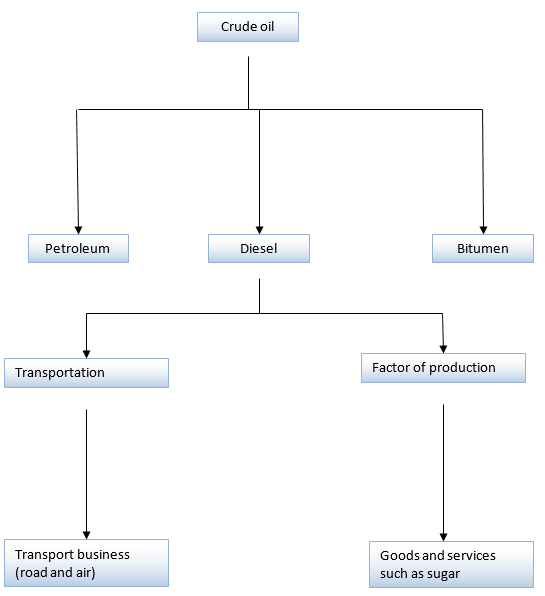
Explanation
From figure 1.0, crude produces several products such as diesel, petroleum, and bitumen. Diesel is consumed as a factor of production and transportation. As a factor of production, diesel is directly used in machinery to produce products such as flour. Similarly, petroleum is used for the production of heating oil and gasoline. Butmen is directly used in the construction of road among other uses. The other end products in the production of crude oil are used for various activities. Therefore, the production of one product yields a complex interrelated chain of input and output in the economy.
Demand and supply of crude oil before changes
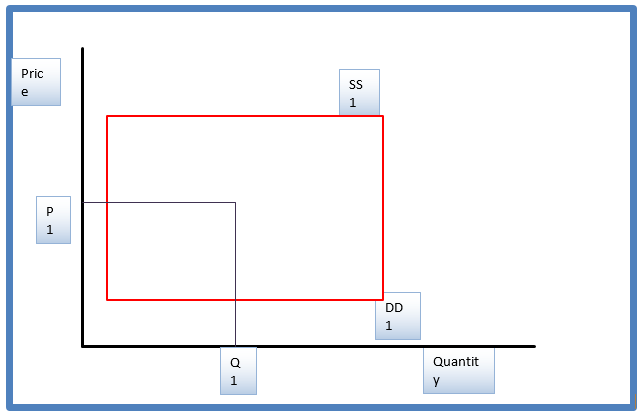
Explanation
Figure 1.1 shows the initial equilibrium status of crude oil before the changes in the price. DD1 shows the demand curve while SS1 shows the supply curve. The equilibrium point is where the supply curve meets the demand curve. Equilibrium price and quantity are P1 and Q1 respectively.
Demand and supply of crude oil after changes in the price
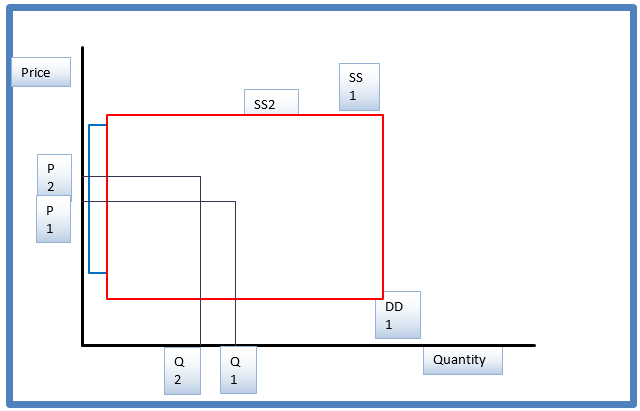
Explanation
An increase in the price of crude oil per barrel causes an inward shift of the supply curve from SS1 to SS2. This gives a new equilibrium position. Price increase from P1 to P2. The equilibrium quantity declines from Q1 to Q2. This indicates a shortage in the supply of crude oil. The net effect of an increase in the price of crude oil a contraction of the supply side of the economy.
Effect of increase in the price of crude oil on specific commodities
This section discusses the effect of the increase in the price of crude oil on specific products. It discusses the impact of an increase in the price of crude oil on the market for gasoline, cars, diesel, heating oil, and gas. The section highlights the relationship between the product and crude oil. It also shows the side of the economy (demand or supply-side) that it is affected. Finally, it shows the impact on the equilibrium quantity and price.
First market: Gasoline
- Event: Increase in the price of crude oil due to the global economic meltdown.
- Relations: Processing of crude oil yields petroleum as one of the by-products. Petroleum goes through fractional distillation and yields several gasses such as gasoline.
- Affected side: Increase in the price of crude oil reduces the supply of crude oil hence a decline in the supply of petroleum. The decline in the supply of petroleum results in contraction of the supply side of gasoline.
- Effect: Increase in the price of crude oil results in a decline in the production of gasoline. The supply curve shifts to the left from SS1 to SS2.
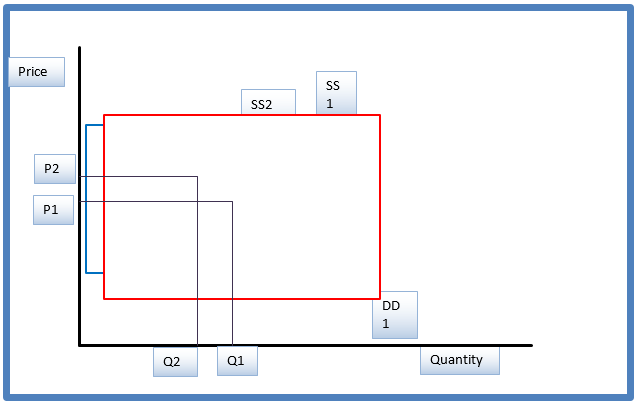
Result: From the graph above, the price of gasoline increases from P1 to P2 while the quantity supplied declines. Price P1 and quantity Q1 show the initial equilibrium position before the changes.
Second market: Cars
Event: Increase in the price of crude oil due to the global economic meltdown.
Relations: Processing of crude oils yields fuel used in cars.
Affected side: Increase in the price of crude oil results in a decline in the production of fuel. The decline in production creates disequilibrium thus resulting in a decline in demand for fuel.
Effect: Increase in the price of crude oil results in a decline in the production of fuel thus creating a shortage which leads to an increase in price. An increase in price results in a decline in demand for fuel, which is an inward shift from DD1 to DD2.
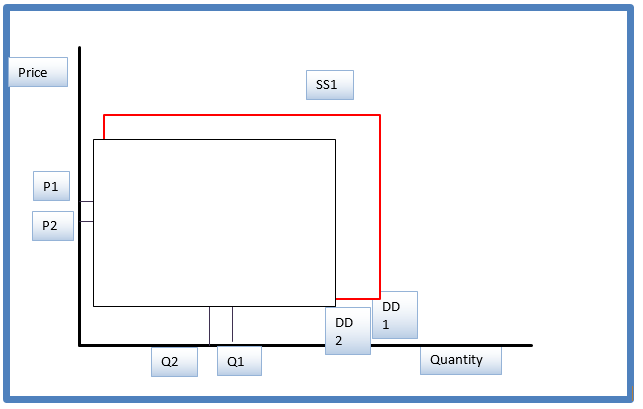
Result: From the graph above, the decline in demand forces the price to decline from P1 to P2 and the quantity of fuel demanded declines from Q1 to Q2. Price P1 and quantity Q1 show the initial equilibrium position before the changes.
Third market: Diesel
Event: Increase in the price of crude oil due to the global economic meltdown.
Relations: processing of crude oil yields diesel as one of the outputs.
Affected side: Increase in the price of crude oil affects the supply side of diesel.
Effect: Increase in the price of crude oil results in a decline in the production of diesel hence a decline in supply.
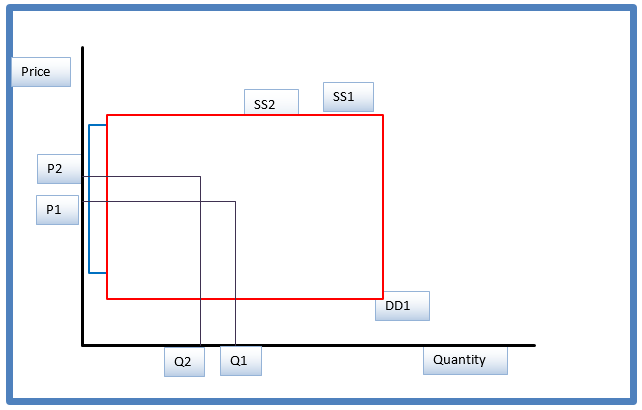
Result: From the graph above, the price of diesel increases while the quantity supplied declines. Price P1 and quantity Q1 show the initial equilibrium position before the changes.
Fourth market: Heating oil
Event: Increase in the price of crude oil due to the global economic meltdown.
Relations: processing of crude oil yields petroleum as one of the byproducts. Petroleum goes through further processing and it yields several byproducts such as heating oil ( an example of heating oil is kerosene).
Affected side: Increase in the price of crude oil reduces the supply of crude oil hence a decline in the supply of petroleum. The decline in the supply of petroleum results in contraction of the supply side of heating oil.
Effect: Increase in the price of crude oil results in a decline in the production of gasoline. This makes the supply curve of heating oil to shift to the left from SS1 to SS2.
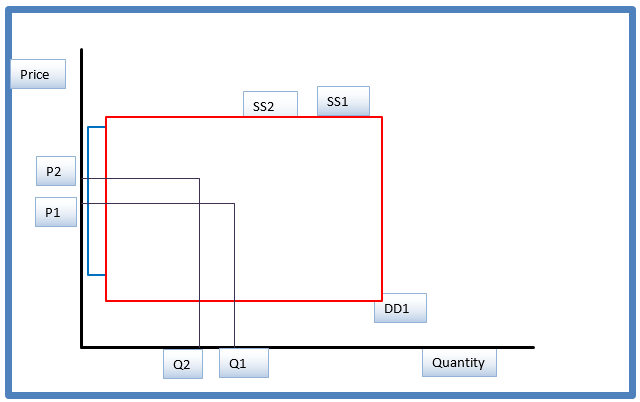
Result: From the graph above, the price of heating oil increases from P1 to P2 while the quantity supplied declines from Q1 to Q2. Price P1 and quantity Q1 show the initial equilibrium position before the changes.
Fifth market: Gas
Event: Increase in the price of crude oil due to the global economic meltdown.
Relations: Processing of crude oil yields petroleum as one of the by-products. Petroleum goes through fractional distillation and yields several gasses.
Affected side: Increase in the price of crude oil results in a decline in the production of petroleum. A decline in production petroleum results in a decline in production of gas thus contracts in the gas supply side.
Effect: Increase in the price of crude oil results in a decline in the production of gas. The supply curve shifts to the left from SS1 to SS2.
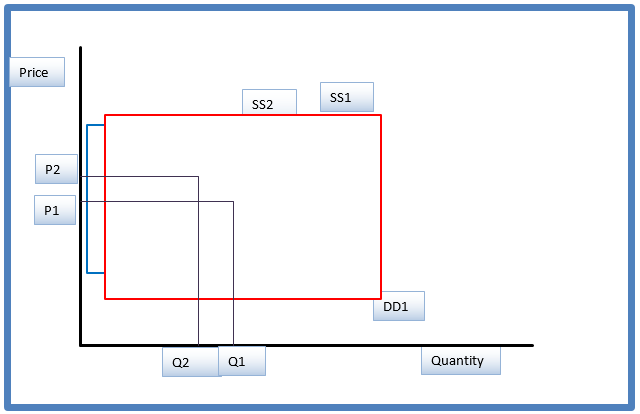
Result: From the graph above, the price of gas increases from P1 to P2 while the quantity supplied declines from Q1 to Q2. Price P1 and quantity Q1 show the initial equilibrium position before the changes.
Conclusion
The paper explains the effect of an increase in the price of crude oil on the economy. Specifically, it looks at the impact of an increase in prices of crude oil on the market for gasoline, cars, diesel, heating oil, and gas. From the discussion above, it is apparent that an increase in the price of crude oil affects the supply side of the economy massively. It causes a decline in the quantity supplied. This leads to an increase in the price of the byproducts.
An increase in the price of byproducts increases the cost of production of goods and services. Further, it leads to a decline in demand for byproducts which are consumed directly such as fuel for cars. This results in to increase in the price of goods and services and a decline in the equilibrium quantity.
